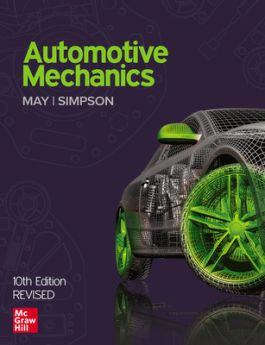Automotive Mechanics, 10th Edition, Revised (with Connect) Blended Learning Pack
Receive via shipping:
- Colour, print bound version of the complete text
1: Motor vehicle components
2: Workshop safety
3: Workshop practices
4: Tools and their uses
5: Measuring and checking
6: Friction and bearings
7: Seals, gaskets and sealants
8: Fuels, fluids and lubricants
9: Service and maintenance
Part 2 Running gear
10: Tyres, wheels and balance
11: Brakes
12: Suspension systems
13: Steering systems
14: Wheel alignment
Part 3 Engines and engine systems
15: Engine fundamentals
16: Engine construction
17: General engine service
18: Cylinder head repair and overhaul procedures
19: Cylinder block repair and overhaul
20: Cooling systems and servicing
21: Engine-lubricating systems
22: Intake and exhaust systems and servicing
Part 4 Transmissions and drives
23: Clutches and service
24: Manual transmissions, transaxles, four-wheel and all-wheel drive service
25: Drive lines and shafts
26: Rear axle and final drive service
27: Automatic transmissions: torque converters
28: Automatic transmissions: mechanical
29: Automatic transmissions: hydraulics and controls
30: Automatic transmission service
Part 5 Petrol fuel and engine management
31: EFI petrol fuel systems
32: Ignition systems
33: Emission controls
34: Diagnosis: petrol engines and other vehicle systems
Part 6 Diesel engines
35: Diesel engines: features
36: Diesel fuel systems
37: Diesel fuel systems service
Part 7 Electrical basics
38: Basic electrics
39: Effects and applications of electric currents
40: Basic electronics
41: The battery
Part 8 Electrical systems
42: Starting systems and service
43: Charging systems and service
44: Body electrical systems and service
45: Instruments and warning systems
46: Vehicle computer systems
Part 9 Alternative drive systems
47: Hybrid, all-electric and fuel-cell vehicles
Part 10 Safety, security and convenience
48: Braking: ABS, traction control and vehicle stability
49: Air conditioning
Part 11 The environment
50: The environment and the automotive service industry
51: online Identify basic automotive faults using troubleshooting processes
52: online Workplace communications
53: online Carburettor fuel systems
This market-leading resource has been providing students with an introduction to the service, diagnosis and repair of passenger and light commercial vehicles for over 48 years.
This revised edition now addresses the needs of students studying the qualifications AUR20520 Cert II in Automotive Servicing Technology and AUR30620 Certificate III in Light Vehicle Mechanical Technology. Updated content includes extended coverage on electrical and hybrid vehicles. The resource also now includes the chapter ‘The environment and the automotive service industry’ within the text (previously found online only). The revised edition also includes QR codes at key sections that take students directly to instructional videos. Video topics include dismantling an oil pump, checking bearing oil clearance and checking engine valves, amongst others.
The content ensures full coverage of the latest vehicle computer systems and diagnostic techniques. The resource is available both in print and eBook versions and is complimented by a suite of online resources that provide students with practical tasks and quizzes to help them consolidate their learning.
Key Features:
- Trusted and reliable content of the highest quality
- Language and use of images appropriate and suited to Certificate II and III students
- Covers all core units and the most popular electives from both the Certificate II and Certificate III courses
- A single volume course book that students will be able to refer to during and after their training
- Digital resources available for trainers to assist in the delivery of courses, and for students to practice their skills and review their knowledge
- Now includes online video content to assist students’ understanding of key concepts
- Key line drawings have now been colour-coded to aid student comprehension

